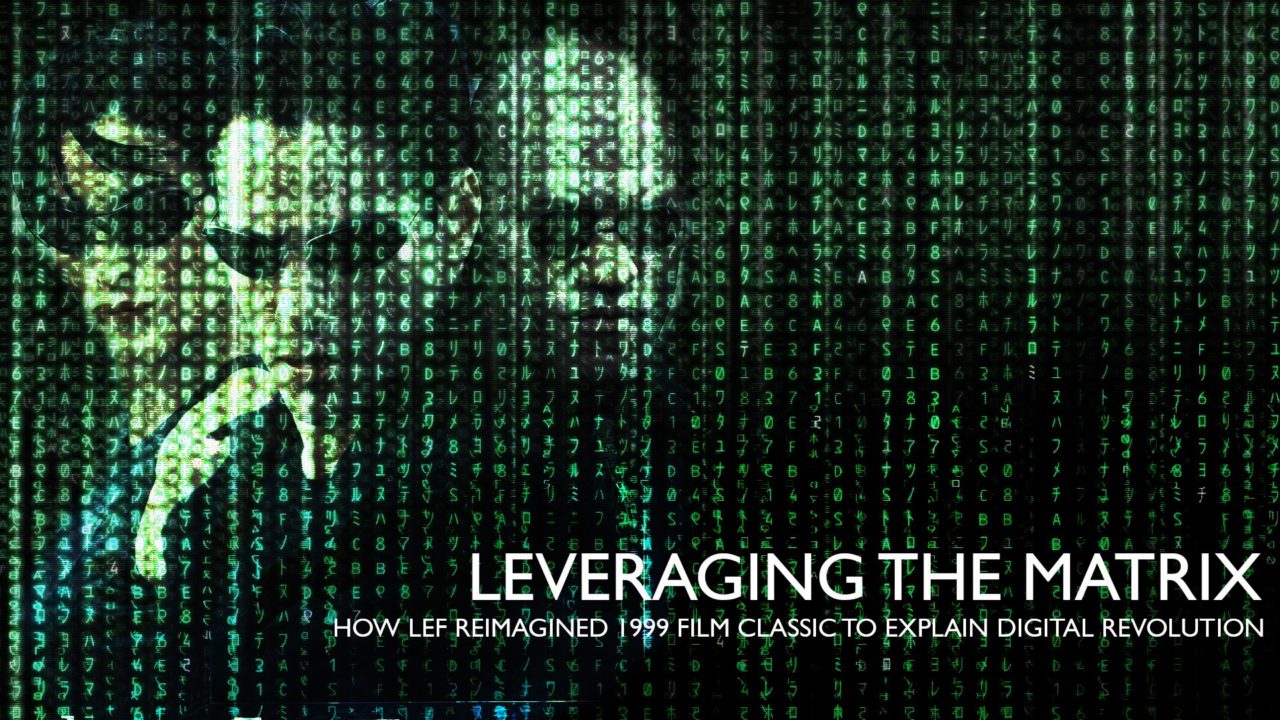How LEF reimagined Wachowski Brothers 1999 classic to explain Digital Revolution
Serious business content tends to take a serious approach. Especially when your subject matter is the digital revolution – affecting the very existence of firms and by extension, the careers of management.
However as Tim Washer of Comedy Central fame (and now Cisco) explained to yBC four years ago, such approaches may not always be the best for video. Tim famously convinced IBM to make funny videos about multi-million dollar IT purchasing decisions for his iconic Mainframe series. Taking a different approach resulted in huge engagement within the hard to impress world of CTOs.
Yet while most corporates understandably turn away from the risks of trying to be funny, it is still worth considering how to make your videos fun.
After all, we are dealing with sophisticated media consumers for whom being entertained is second nature. We don’t want to be bored, lectured or told what to think.
Emotions and stories are what film has always been about.
We want to be intrigued, thrilled, inspired, scared… we want to be grabbed in some way.
We don’t need to be told the story with powerpoint bullets. A lifetime of TV means we can follow the action by ourselves, provided there is a powerful story being told.
And today’s audience, increasingly armed with smartphones and iPads will invest that 2, 3, or 5 minutes even on the go as long as you give them a compelling reason to watch.
So it’s always worth exploring creative ways to tell your story in a way that will better connect with your audience.
Our client, LEF, saw that ‘fun” opportunity in the 1999 Sci-Fi classic, The Matrix.
It’s a film almost everyone of my generation (Gen X – aged 35-50) knows.
We remember the Nokia phone. Keanu Reeves. Bullet time!
LEF noticed how our new digital infrastructure also reflects some of the predictions of the film.
No. Not the idea of us all living in an computer simulation. (Thank goodness!). But rather that the digital world is becoming pervasive, ever-smarter and even self-aware. Machine intelligences automatically work with each other without human involvement.
As LEF explain:
In the 20th century businesses relied on a physical infrastructure of transportation, lighting, cooling, stores and offices. But today there is a second and even more powerful virtual infrastructure emerging
History suggests major shifts in our economic foundations often result in new business dynamics and new industry leaders. Not all firms will make the transition
… and the societal effects will be even greater.
This ever-richer set of digital services is becoming the economic foundation of our time.
We call this emerging new digital foundation, The Matrix, with a nod to the famous 1999 film
So that was the opportunity. But how to re-imagine “The Matrix” – a film famous for A list actors and ground breaking (and expensive) special effects?
The Matrix was still a huge investment for Warner Bros, which had to invest $60 million to create a movie with deep philosophical ideas and difficult special effects.
What we needed to do was create a tie-in to the film, helping to tell a story from familiar reference points, without being too cheesy.
To do that we decided to use modern animation power to tell a similar story, on a corporate video style budget.
The key idea was to replicate some key scenes/themes. The setting. The phones. The data screens.
In particular we could recreate a “noir city” in which the action could take place. Using understandable locations helps audiences to understand complex ideas – as there is an actual story and narrative to follow, rather than just a collection of ideas. (Too many companies simply use video as powerpoint, with no “story telling” and lots of “key message telling”.)
Our film culminated in the classic digital jump between skyscrapers.
C-suite leaders need to understand they are no longer bound by the physical world with it’s old architectures. They need to take a jump – into the world of key Matrix players.
But just as it would have been unwise for the business leaders of the 1920s to ignore the technology revolutions of that time, so today’s business leaders must not ignore the digital infrastructure that is expanding all around us.
The film was produced in a two week timeframe from scripting to delivery due to a key event being held in Washington DC. Our client wanted this to be a signature hero video – something which would get its members really talking – and by all accounts the video has hit the mark. Our key client within the LEF described this video as “the best video yet”. Now that’s a review to be proud of …



